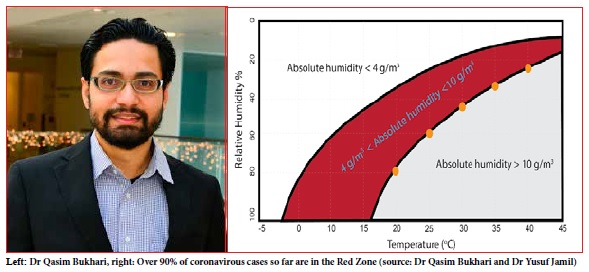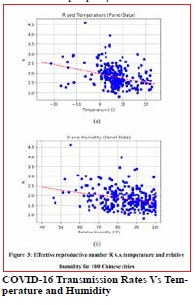World Media Highlights Pakistani-American’s Research Findings on Coronavirus
By Riaz Haq
CA

Mainstream Western and Indian media have widely covered a recent MIT paper by a Pakistani-American scientist at Massachusetts Institute of Technology (MIT) on the effects of heat and humidity on the coronavirus pandemic. Dr Qasim Bukhari, the lead author, is an alumnus of NED University located in Karachi, Pakistan. The paper is posted on Social Science and Research Network (SSRN). It has been mentioned in reports by The New York Times, Washington Post, Time, Forbes, Times of India, The Hindu, India Today and many other publications.
The paper shows that 90% of the coronavirus (COVID-19 or 2019-nCoV) cases so far have occurred in regions with absolute humidity between 4 and 10 grams per cubic meter. One possible reason for this is that the fatty outer layer of the virus has trouble surviving in high heat and humidity. The virus disintegrates when the fatty outer cover is gone in a way similar to how soap and hot water destroy it.
This may explain why there appear to be relatively few reports of local COVID-19 transmissions in places like Pakistan. Most of the known coronavirus cases in Pakistan appear to be those of the people who have come into the country from cold, dry places like northern Iran where the pandemic is raging. The rate of local transmission in Pakistan is not zero but relatively low. Dr Bukhari says that “there is indeed evidence that weather plays a role, but in no way we are suggesting that this role alone would be so decisive as to completely halt the spread of COVID.”

Bukhari and Jamil
The paper titled “Will Coronavirus Pandemic Diminish by Summer?” written by Dr Qasim Bukhari and Dr Yusuf Jamil explains that “several countries between 30N and 30S such as Australia, UAE, Qatar, Singapore, Bahrain, Qatar and Taiwan have performed extensive testing per capita and the number of positive 2019-nCoV cases per capita is lower in these countries compared to several European countries and the US”. “The relation between the number of 2019-nCoV cases and temperature and absolute humidity observed here is strong; however, the underlying reasoning behind this relationship is still not clear”, they write.
Here’s a brief Question/Answer version of the email exchange I had with Dr Bukhari:
RH: My understanding from the data I have seen from various sources is that the coronavirus transmission rates decline but do not necessarily go to zero in hot and humid weather. And the reason is that the fatty outer layer of the virus has trouble in heat and humidity. Is that accurate?
QB: That would be almost accurate. The only thing we don’t know so far is how much decline in growth rate we are talking about. It is definitely non-zero. The underlying reasons may be many or either of many. One reason could be the fatty outer layer that you mentioned. The other reason could be the antibacterial nature of sunlight, another reason could be low indirect transmission (through air) in high humidity.
Sounding a note of caution, here’s what Dr Bukhari wrote to me:
“There is indeed evidence that weather plays a role, but in no way we are suggesting that this role alone would be so decisive as to completely halt the spread of COVID. And anyway, the effect of this weather would only be relevant in humid hot countries. Please do share, but please use the right words that properly communicate that it is incredibly important to take precautions and quarantine measures even in the most humid hot regions, as the spread would keep on going without that; we have evidence from Singapore, Malaysia and Indonesia of this.”

Wang, Weifeng, Beihang and Ke Tang
There is similar work that has recently been published by a Chinese research team that included Jingyuan Wang, Kai Feng, Weifeng Lv of Beihang University, and Ke Tang of Tsinghua University. They studied 100 different Chinese cities that each reported more than 40 cases of COVID-19 from January 21-23, 2020.
“In the early dates of the outbreaks, countries with relatively lower air temperature and lower humidity (e.g. Korea, Japan and Iran) saw severe outbreaks than warmer and more humid countries (e.g. Singapore, Malaysia and Thailand) do,” the researchers reported.
Here’s an excerpt from the abstract published by the team:
“After estimating the serial interval of COVID-19 from 105 pairs of the virus carrier and the infected, we calculate the daily effective reproductive number, R, for each of all 100 Chinese cities with more than 40 cases. Using the daily R values from January 21 to 23, 2020 as proxies of non-intervened transmission intensity, we find, under a linear regression framework for 100 Chinese cities, high temperature and high relative humidity significantly reduce the transmission of COVID-19, respectively, even after controlling for population density and GDP per capita of cities. One-degree Celsius increase in temperature and one percent increase in relative humidity lower R by 0.0383 and 0.0224, respectively. This result is consistent with the fact that the high temperature and high humidity significantly reduce the transmission of influenza. It indicates that the arrival of summer and rainy season in the northern hemisphere can effectively reduce the transmission of the COVID-19.”
Some experts are pointing to the increased amount of UV rays from the sun the Northern Hemisphere will be subject to this time of the year as a factor that could slow down the virus, according to a story in AccuWeather.
Summary: Mainstream US and Indian media have widely covered a recent MIT paper on the effects of heat and humidity on coronavirus transmission. Dr Qasim Bukhari, the lead author and alumnus of the NED University located in Karachi, Pakistan, has shared data showing that 90% of the coronavirus cases so far have occurred in regions with absolute humidity between 4 and 10 grams per cubic meter. Recent Chinese research is also showing that hot and humid weather may significantly slow down transmission of the coronavirus or COVID-19. An increase of just one degree Celsius and 1% relative humidity increase substantially lower the (Covid-19 or 2019-nCoV) virus’s transmission, says a study published on March 10, 2020 by Chinese researchers. One possible reason is that the fatty outer layer of the virus has trouble surviving in high heat and humidity. The virus disintegrates when the fatty outer cover is gone in a way similar to how soap and hot water destroy it. This may explain why there appear to be relatively few reports of local COVID-19 transmissions in places like Pakistan. Most of the known coronavirus cases in Pakistan pertain to people who have come into the country from cold, dry places like northern Iran where the pandemic is raging. The rate of local transmission in Pakistan is not zero but relatively low. Dr Bukhari says that “there is indeed evidence that weather plays a role, but in no way we are suggesting that this role alone would be so decisive as to completely halt the spread of COVID.”
(Riaz Haq is a Silicon Valley-based Pakistani-American analyst and writer. He blogs at www.riazhaq.com)
-----------------------------------------------------------------------------

